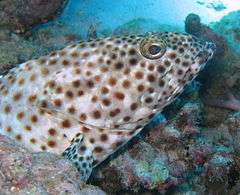Greasy grouper
| Greasy grouper | |
|---|---|
 | |
| Scientific classification | |
| Kingdom: | Animalia |
| Phylum: | Chordata |
| Class: | Actinopterygii |
| Order: | Perciformes |
| Family: | Serranidae |
| Genus: | Epinephelus |
| Species: | E. tauvina |
| Binomial name | |
| Epinephelus tauvina (Forsskål, 1775) | |
| Synonyms | |
| |
The greasy grouper (Epinephelus tauvina), also known as the Arabian grouper, is an Indo-Pacific fish species of economic importance.
Description
The fish grows up to 75 cm (30 inches) in length. Its head and body are pale greenish grey or brown with round spots, varying from orange-red to dark brown. A group of black spots may be visible on the body at the base of the rear of the dorsal fin. Five vertical darker shaded bars may also be present on the body. It is similar to E. corallicola and E. howlandi, which, however, have shorter bodies and spots less closely spaced.[2]
Due to confusion about identifying species, much of the earlier (particularly pre-1984) literature referring to E. tauvina may actually refer to other species of grouper, including Epinephelus coioides, Epinephelus malabaricus and Epinephelus lanceolatus.[1]
Distribution and habitat
The greasy grouper occurs in the Red Sea and the East African coast, east to the Pitcairn group, north to Japan, and south to Lord Howe Island. Records from the south China Sea, Taiwan, Australia, and various islands off North America exist.[1]
The species inhabits clear water areas on coral reefs (at depths of up to 50 m), although juveniles may venture into reef flats, tidepools and mangrove estuaries. The greasy grouper feeds on small fish and sometimes crustaceans.[1]
Fisheries
The greasy grouper is caught in recreational fisheries (including spear- and hook-and-line fishing) and plays a major role in commercial fisheries. It is also found in the aquarium trade.[1] Total production in 2013 was 16,234 tonnes (combined recreational fisheries, commercial fisheries and aquaculture).[3]
References
- 1 2 3 4 5 Rhodes, K.L., Russell, B., Pollard, D. & Kulbicki, M. (2008). "Epinephelus tauvina". IUCN Red List of Threatened Species. IUCN. 2008: e.T132758A3443010. Retrieved 22 December 2015.
- ↑ Froese, Rainer and Pauly, Daniel, eds. (2007). "Epinephelus tauvina" in FishBase. 4 2007 version.
- ↑ "FAO: FIGIS query for Greasy Grouper total production". FAO - Fisheries and Aquaculture Information and Statistics Branch. Retrieved 23 December 2015.
